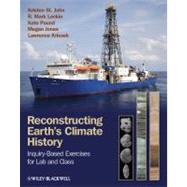
Note: Supplemental materials are not guaranteed with Rental or Used book purchases.
Purchase Benefits
What is included with this book?
Dr. R. Mark Leckie is a Professor of Geology at the University of Massachusetts-Amherst. Leckie is a marine micropaleontologist and specializes in paleoceanography, particularly reconstructing ocean-climate history of the past 120 million years. He has participated in six DSDP/ODP scientific expeditions, and served as Co-Chief Scientist of ODP Leg 165. His teaching responsibilities include: Introductory Oceanography; History of the Earth; Introductory Field Methods; Paleoceanography; and Marine Micropaleontology.
Dr. Kate Pound is a Professor of Geology, and a member of the Science Education Group at St. Cloud State University. Pound leads hands-on education and outreach programs for teachers in Minnesota, and was a science educator in the ANDRILL program in Antarctica. Her research focuses on provenance studies and regional tectonics. Her teaching responsibilities include: Physical Geology, Glacial Geology, Field Geology, Rocks & Minerals, Sedimentology, General Education Geology courses, and Science for Elementary Teachers.
Dr. Megan Jones is a Professor of Geology at North Hennepin Community College, a diverse, open-access institution. Jones' broad background and experience in marine micropaleontology/paleoceanography, sed/strat and field geology offers her students options to pursue field experiences and undergraduate research. Her research interest focuses on the connections between student motivation and success in introductory science courses. Her teaching responsibilities include: Physical and Historical Geology, Oceanography, and Minnesota Field Geology.
Dr. Lawrence Krissek is a Professor in the School of Earth Sciences, Ohio State University. His primary scientific research is the study of the evolution of climates and ocean environments on the earth during the past 65 million years. He has conducted field research in the Antarctic, and has sailed on numerous DSDP, ODP, and IODP cruises. He teaches Oceanography, Oceanography for Educators, Field Geology for Educators, Natural Hazards, Physical Geology, Historical Geology, and Stratigraphy and Sedimentation.
Acknowledgments
Book Introduction for Students and Instructors
Geologic Timescale
Chapter 1. Introduction to Paleoclimate Records.
Part 1.1. Archives and Proxies
Part 1.2. Owens Lake – An Introductory Case Study of Paleoclimate Reconstruction
Part 1.3. Coring Glacial Ice and Seafloor Sediments
Chapter 2. Seafloor Sediments.
Part 2.1. Sediment Predictions
Part 2.2. Core Observations and Descriptions
Part 2.3. Sediment Composition
Part 2.4. Geographic Distribution and Interpretation
Chapter 3. Microfossils and Biostratigraphy.
Part 3.1. What are Microfossils? Why are they Important in Climate Change Science?
Part 3.2. Microfossils in Deep-sea Sediments
Part 3.3. Application of Microfossil First and Last Occurrences
Part 3.4. Using Microfossil Datums to Calculate Rates
Part 3.5. How Reliable are Microfossil Datums?
Chapter 4. Paleomagnetism and Magnetostratigraphy.
Part 4.1. Earth's Magnetic Field Today and the Paleomagnetic Record of Deep-Sea Sediments
Part 4.2. Paleomagnetism in Ocean Crust
Part 4.3. Using Paleomagnetism to Test the Seafloor Spreading Hypothesis
Part 4.4. The Geomagnetic Polarity Time Scale
Chapter 5. CO2 as a Climate Regulator during the Phanerozoic and Today.
Part 5.1. The Short Term Global Carbon Cycle
Part 5.2. CO2 and Temperature
Part 5.3. Recent Changes in CO2
Part 5.4. The Long-term Global Carbon Cycle, CO2, and Phanerozoic Climate History
Chapter 6. The Benthic Foraminiferal Oxygen Isotope Record of Cenozoic Climate Change.
Part 6.1. Introduction
Part 6.2. Stable Isotope Geochemistry
Part 6.3. A Biogeochemical Proxy
Part 6.4. Patterns, Trends and Implications for Cenozoic Climate
Chapter 7. Scientific Drilling in the Arctic Ocean: A Lesson on the Nature of Science.
Part 7.1. Climate Models and Regional Climate Change
Part 7.2. Arctic Drilling Challenges and Solutions
Part 7.3. The Need for Scientific Drilling
Part 7.4. Results of the Arctic Drilling Expedition
Chapter 8. Climate Cycles.
Part 8.1. Patterns and Periodicities
Part 8.2. Orbital Metronome
Part 8.3. A Break in the Pattern
Chapter 9. The Paleocene Eocene Thermal Maximum (PETM) Event.
Part 9.1. The Cenozoic δ13C Record and an Important Discovery
Part 9.2. Global Consequences of the PETM
Part 9.3. Bad Gas: Is Methane to Blame?
Part 9.4. How fast? How long?
Part 9.5. Global Warming Today and Lessons from the PETM
Chapter 10. Glaciation of Antarctica: The Oi1 Event.
Part 10.1. Initial Evidence
Part 10.2. Evidence for Global Change
Part 10.3. Mountain Building, Weathering, CO2 and Climate
Part 10.4. Legacy of the Oi1 Event: The Development of the Psychrosphere
Chapter 11. Antarctica and Neogene Global Climate Change.
Part 11.1. What do we Think we Know about the History of Antarctic Climate?
Part 11.2. What is Antarctica’s Geographic & Geologic Context?
Part 11.3. Selecting Drillsites to Best Answer our Questions
Chapter 12. Interpreting Antarctic Sediment Cores: A Record of Dynamic Neogene Climate.
Part 12.1. What Sediment Facies are Common on the Antarctic Margin?
Part 12.2. ANDRILL 1-B The BIG Picture
Part 12.3. Pliocene Sedimentary Patterns in the ANDRILL 1-B Core
Ch. 13. Pliocene Warmth: Are We Seeing Our Future?
Part 13.1. The last 5 million years
Part 13.2. Sea Level Past, Present, and Future
Chapter 14. Northern Hemisphere Glaciation.
Part 14.1. Concepts & Predictions
Part 14.2. What is the Evidence?
Part 14.3. What Caused It?
Index
The New copy of this book will include any supplemental materials advertised. Please check the title of the book to determine if it should include any access cards, study guides, lab manuals, CDs, etc.
The Used, Rental and eBook copies of this book are not guaranteed to include any supplemental materials. Typically, only the book itself is included. This is true even if the title states it includes any access cards, study guides, lab manuals, CDs, etc.